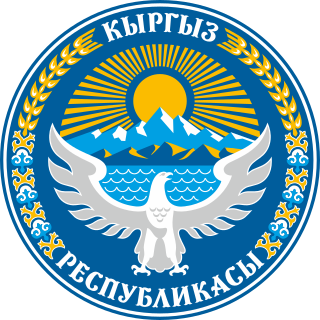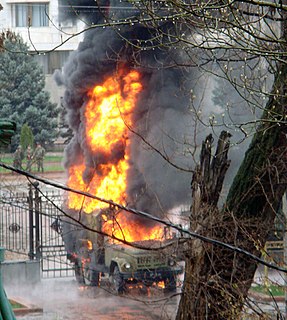
The history of the Kyrgyz people and the land now called Kyrgyzstan goes back more than 2,000 years. Although geographically isolated by its mountainous location, it had an important role as part of the historical Silk Road trade route. In between periods of self-government it was ruled by Göktürks, the Uyghur Empire, and the Khitan people, before being conquered by the Mongols in the 13th century; subsequently it regained independence but was invaded by Kalmyks, Manchus and Uzbeks. In 1876 it became part of the Russian Empire, remaining in the USSR as the Kirghiz Soviet Socialist Republic after the Russian Revolution. Following Mikhael Gorbachev's democratic reforms in the USSR, in 1990 pro-independence candidate Askar Akayev was elected president of the SSR. On 31 August 1991, Kyrgyzstan declared independence from Moscow, and a democratic government was subsequently established.

The Politics of Kyrgyzstan, officially known as the Kyrgyz Republic takes place in the framework of a parliamentary representative democratic republic, whereby the President is head of state and the Prime Minister of Kyrgyzstan is head of government. Executive power is exercised by the government. Legislative power is vested in both the government and parliament. The Economist Intelligence Unit rated Kyrgyzstan a "hybrid regime" in 2019.
Communications in Libya describes the overall environment for the radio, television, telephone, Internet, and newspaper markets in Libya.
Telecommunications in Nicaragua include radio, television, fixed and mobile telephones, and the Internet.
Telecommunications in Rwanda include radio, television, fixed and mobile telephones, and the Internet.
Telecommunications in Suriname includes radio, television, fixed and mobile telephones, and the Internet.
Telecommunications in Madagascar include newspapers, radio, television, fixed and mobile telephones, and the Internet.
Telecommunications in the Gambia includes radio, television, fixed and mobile telephones, and the Internet.

Kyrgyzstan, officially the Kyrgyz Republic, and also known as Kirghizia, is a country in Central Asia. Kyrgyzstan is a landlocked country with mountainous terrain. It is bordered by Kazakhstan to the north, Uzbekistan to the west and southwest, Tajikistan to the southwest and China to the east. Its capital and largest city is Bishkek.
The media of Kazakhstan refers to mass media outlets based in The Republic of Kazakhstan. Media of Kazakhstan are a set of public information transfer agencies in the Republic of Kazakhstan. The Constitution of Kazakhstan guarantees freedom of press, but privately owned and opposition media have been subject of censorship. In 2004 the International Federation of Journalists identified a "growing pattern" of intimidation of the media, and in 2012 several opposition media outlets were ordered to be shut down on charges of promoting "extremism".
The media of Transnistria, the breakaway territory within the borders of Moldova, features both state-owned or supported outlets and opposition media. Publications are in Russian, with a single newspaper in each of the other two official languages, Moldovan (Romanian), and Ukrainian. Allegations of propaganda have emerged internationally.

The Constitution of Kyrgyzstan is the supreme law of the Kyrgyz Republic. The constitution in force until 2010 was passed by referendum on 21 October 2007 and it is based on the first post-Soviet constitution originally adopted on 5 May 1993, a year and a half after the country had gained independence from the former Soviet Union. The 1993 constitution had been amended several times: first on 10 February 1996, then on 2 February 2003, and finally twice in quick succession on 9 November 2006 and 15 January 2007 after the Tulip Revolution of March 2005. The last two amendments were adopted under pressure from protracted public protests in the capital Bishkek, but they were annulled in September 2007 by the Constitutional Court, which restored the 2003 constitution and paved the way for another constitutional referendum in October 2007. The description that follows is based on the text of the October 2007 constitution.
Daniar Toktogulovich Usenov is a Kyrgyz banker and politician who served as the Prime Minister of Kyrgyzstan from October 2009 to April 2010. He previously served as Mayor of Bishkek.

The following outline is provided as an overview of and topical guide to Kyrgyzstan: Kyrgyzstan – sovereign country located in Central Asia. Landlocked and mountainous, Kyrgyzstan is bordered by Kazakhstan to the north, Uzbekistan to the west, Tajikistan to the southwest, and China to the east.
The print, broadcast and online media of Burma has undergone strict censorship and regulation since the 1962 Burmese coup d'état. The constitution provides for freedom of speech and the press; however, the government prohibits the exercise of these rights in practice. Reporters Without Borders ranked Burma 174th out of 178 in its 2010 Press Freedom Index, ahead of just Iran, Turkmenistan, North Korea, and Eritrea. In 2015, Burma moved up to 144th place, ahead of many of its ASEAN neighbours such as Singapore, as a result of political changes in the country.

The media of Ghana, includes television, radio, internet publishing and newspapers.

The media of Mongolia refers to the print, broadcast and online media in Mongolia. Since the collapse of the Soviet style system in 1990, the media has undergone large reforms which have allowed greater diversity and freedom of the press which make it one of the most free in the region. Censorship of media outlets is forbidden under the 1998 Media Freedom Law. In its 2013 report, Reporters Without Borders classified the media environment as 98th out of 179, with 1st being most free.
The media of Bangladesh refers to the print, broadcast and online mass media available in Bangladesh. The Constitution guarantees press freedom and freedom of expression within "reasonable restriction", though some media outlets have been harassed. The Bangladeshi media's rank is dropped to 146 in 2018 from its position of 144 in 2016 out of total 180 countries on the Reporters Without Borders Press Freedom Index, with 1st being most free.

The Kyrgyz Revolution of 2010, also known as the Second Kyrgyz Revolution, the Melon Revolution, the April Events or officially as the People's April Revolution, began in April 2010 with the ousting of Kyrgyz president Kurmanbek Bakiyev in the capital Bishkek. It was followed by increased ethnic tension involving Kyrgyz people and Uzbeks in the south of the country, which escalated in June 2010. The violence ultimately led to the consolidation of a new parliamentary system in Kyrgyzstan.
The following lists events that happened during 2010 in Kyrgyzstan.






